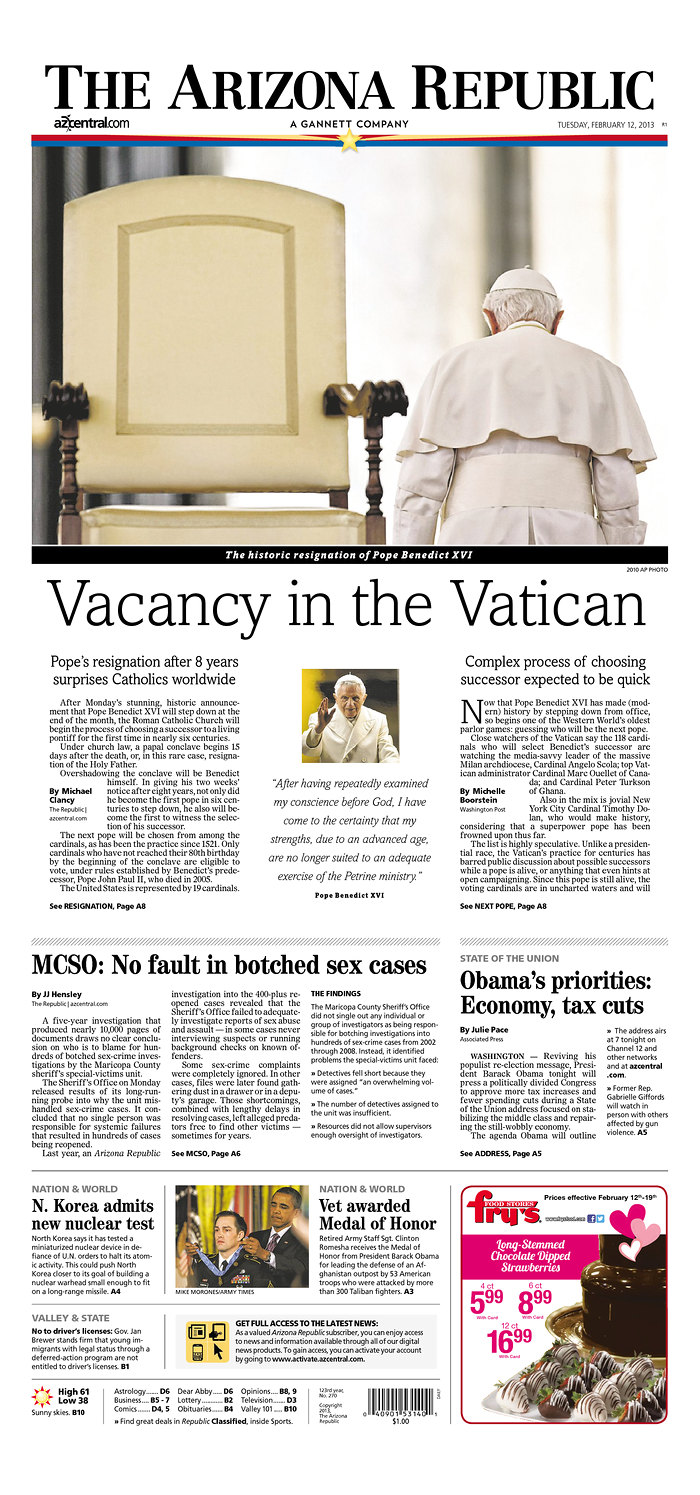
Yesterday’s news tomorrow
It takes less than an hour to drive from Baltimore to Washington, D.C., but it appears that it takes the news a whole lot longer to make that trip.
News of Pope Benedict’s decision to step down broke about 1 a.m. Monday morning and it became an all-morning, all-day topic on television, radio, Web sites galore, and across social media.
Come Tuesday, The Baltimore Sun rightly took a next-day approach in print, “Next Pope, new questions.” http://www.newseum.org/todaysfrontpages/hr.asp?fpVname=MD_TS&ref_pge=gal&b_pge=1
Yet the Tuesday front page of The Washington Post led with a headline that assumed its readers had no access to radio, television, Web sites, Twitter, Facebook, and other forms of social media — not to mention conversations at work, school, the gym, bowling alleys, restaurants, or even in church. In fact, readers probably knew more than The Post’s editors.
In an approach seemingly ripped from a 1980 news desk playbook, The Post on Tuesday morning announced “Pope Benedict to resign” http://www.newseum.org/todaysfrontpages/hr.asp?fpVname=DC_WP&ref_pge=gal&b_pge=1
Perhaps the Post’s print editors assumed no one had read its own Web site, which plastered the news across its home page before dawn on Monday.
The Post was not alone in assuming that its readers were unaware by Tuesday of a 1 a.m. Monday story. That’s a mistake that too many newspapers still make — reporting yesterday’s news tomorrow. It suggests that some print newspaper editors are trapped in a pre-television and radio, pre-Internet, pre-social media mindset that isolates them from their audiences.
This is like playing baseball. No one can run faster than a thrown ball and no print product can beat digital information in a race to a reader.
News organizations need to understand how audience members use media, how they find news and how news finds them. Journalists need to understand what audience members expect of each platform they use.
Social media delivers breaking news first. People typically then turn to broadcast media for elaboration and to Web sites for an initial dose of depth, impact reporting and conversation. What news consumers want from next-day print — if they use it — is context, analysis and a “what’s next” approach that goes beyond what the news organization posted on its own site the day before. Fact is, print does have a future with some audience members but only if it fills that role for them.
Using a “Pope to Resign” headline in this case did nothing but paint a print newspaper as dated and out of touch with its audiences. Small-type refers to analytical and reaction stories on inside pages do little to diminish the dated and out-of-touch feel that a “yesterday headline” creates on the front page.
To succeed, news organizations need to create content and conversation with audience members on the platforms that audiences choose at the times the audience members want to use the platforms. That means news folks need to understand audiences, one at a time, and become a part of the journalism experience within each audience. All of that argues against maintaining separate digital and print operations. Let the audiences drive the approaches.
The alternative is to arrogantly ignore the real world of news creation and consumption, to believe that the publisher’s news is more important than any other news, and to maintain that nothing is official until you read it here first. And that’s a ticket to disaster.
With credit to the Freedom Forum’s front-page gallery, here are some other newspaper front pages that got it right on Tuesday morning.
Mark Silverman is a media consultant, strategist, journalist, and trainer. He has served as the top editor of newspapers in Detroit, Louisville, Nashville, and Rockford IL, as well as Gannett News Service. He has also worked on change and innovation projects during two separate stints on the Gannett Company’s corporate news staff. While competent in many areas, he should never be allowed take still photos or video.




